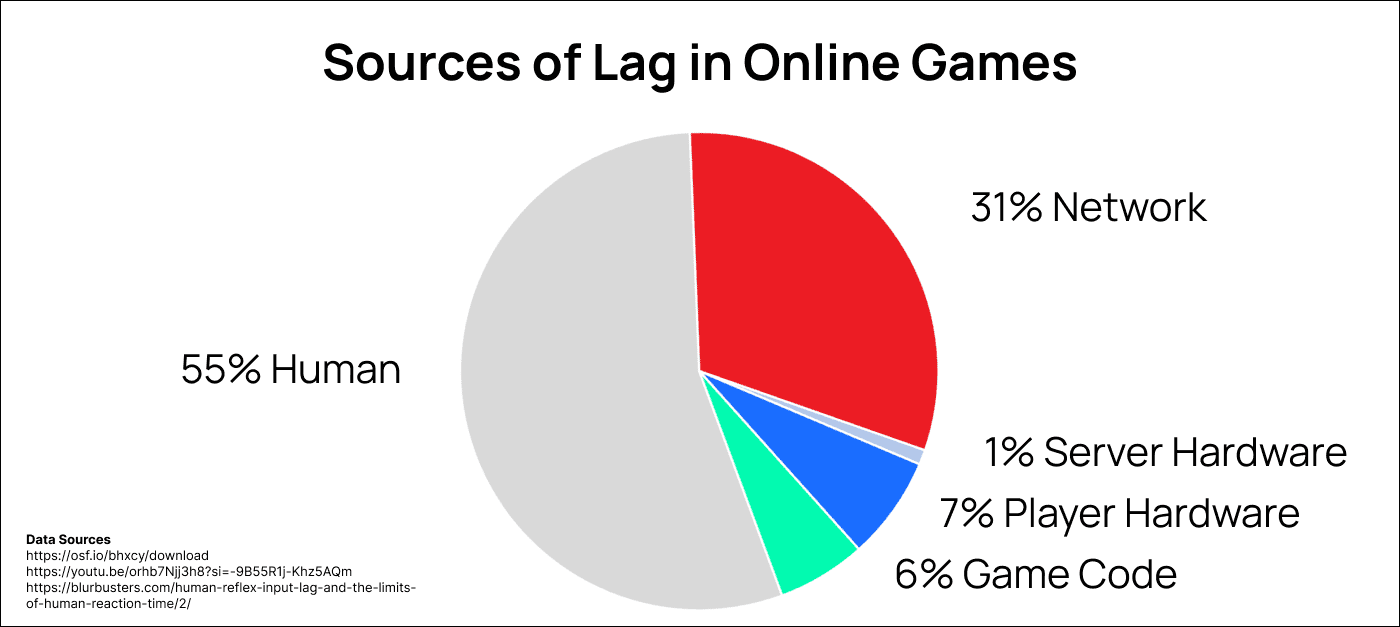
Rollback Netcode for Latency Mitigation - Limitations & Solutions
When it comes to online multiplayer game developments, one of the perennial challenges faced by developers is ensuring smooth gameplay even when faced with the unpredictable nature of internet latency.
To overcome these challenges, many have turned to a technique called "rollback netcode." The first well-documented use of predictive network was from Starsiege: Tribes, release in 1998.
Rollback netcode is a powerful tool to mitigate latency in gameplay, but reducing latency at its source requires infrastructure-level changes – and that’s not an easy feat for game devs.
As research shows, the majority of latency is introduced by the network itself – 31%, when excluding normal human eye/response. Magnitudes over server or player hardware or the game code itself, double that of their total (14%).
Thus, only game server orchestration in combination with a distributed network of public edge infrastructure, like those provided by Edgegap, can tackle this specific element challenge and offer an enhanced play experience that reduces latency, and either reduce the complexity associated with integrating rollback systems by not having to include one, or further improve a game’s mitigation of lag when combined with rollback netcode.

What is Rollback Netcode: A Brief Overview
Rollback netcode is essentially a variant of the traditional input prediction system known in the gaming world as "predictive netcode." Here's a brief rundown of how it works:
Local Prediction: When a player makes a move, their game client predicts the outcome of that action without waiting to receive confirmation from the server or other players. It provides the illusion of instant response, which is necessary for fast-paced games.
Server Validation: The server then receives this input and simulates the outcome as well. If the server's simulation matches the local prediction, all is well. If not, the game has to be corrected.
Rollback: This is where the rollback netcode stands out. Instead of merely correcting future game states, it "rolls back" the game to a point before the error occurred, simulates the correct outcome, and then "fast-forward" to the present. All this happens in a blink of an eye, ideally making it unnoticeable to the player.
Infrastructure-Level Latency Reduction: Edgegap's Answer
Reducing latency at its source sounds like the ideal solution, and it’s exactly what solutions like Edgegap aim to achieve. By deploying game servers closer to players using a distributed network through a smart, automated game server orchestration platform, Edgegap can drastically reduce the round trip time data takes to travel between the player and the server.
Here's why this infrastructure-level approach offers several advantages:
Immediate Reduction in Latency: Traditional centralized servers might be located thousands of miles away from a player. By using a distributed network, Edgegap places the server resources closer to the players, drastically reducing the distance data must travel.
Scalability: Such solutions can automatically scale in sync with user demand, accommodating more players without a proportional increase in latency.
Reduced Workload for Developers: Rollback netcode, while effective, is complex. Developers have to invest time and resources to integrate it correctly. They must also take it into account in their gameplay loop, making concessions that will impact its performance – a massive issue for performance-based games such as fighters, or projects with e-sports communities. By reducing latency at the source, the need for such complex systems can be minimized, if not entirely negated.
Enhanced Player Experience: From a player's perspective, nothing beats a game that feels responsive and smooth. Lower latency translates into faster response times, making for a more immersive and enjoyable gaming experience. Rollback netcode also creates strange behaviours and artefacts for players when the rollback is called. This can result in missed frames are supposed to show a kick, and an overall poor experience as the player is unable to keep up with the back and forth of what’s happening in the game.
Conclusion
While rollback netcode has been a significant leap in ensuring a lag-free experience for online gamers, it's a solution that treats the symptom rather than the cause. It exists primarily to combat the challenges posed by high latency.
If we tackle the problem of latency its root by leveraging infrastructure-level solutions like Edgegap, we can offer players a superior experience. Such an approach ensures a smoother gaming experience and simplifies the developer's job by eliminating or reducing the need for complex systems like rollback netcode.
As the world of online gaming continues to grow and evolve, it's solutions like automated game server orchestration that deploy game server instances nearest users that will pave the way for the next generation of seamless online play.
Try it for yourself for free, or learn how others use Edgegap for their games.
Written by
the Edgegap Team








